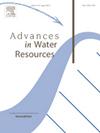Leakage risk assessment in geologic carbon sequestration using a physics-aware ConvLSTM surrogate model
IF 4
2区 环境科学与生态学
Q1 WATER RESOURCES
引用次数: 0
Abstract
The secure implementation of geological carbon sequestration (GCS) critically hinges on accurately localization of CO2 leakage through inverse modeling of plume migration dynamics in heterogeneous reservoirs. This process is inherently challenged by subsurface uncertainties and the complexity of multiphase flow. Advances in various deep-learning-based surrogate models have been made to improve computational efficiency. Especially, Physics-Informed Neural Networks (PINNs) have gained widespread application due to their integration of the partial differential equation (PDE) into the loss function. However, conventional PINNs still face critical limitations in handling two-phase flow dynamics and high-dimensional parameter spaces due to the discretization requirements of PDE. To address these challenges, we propose a Physics-Aware Convolutional LSTM (PA-CLSTM) surrogate model that intrinsically embeds flow gradient information into the ConvLSTM architecture. Unlike PINNs which require PDE discretization as part of the loss function, PA-CLSTM encodes physical constraints through Sobel operator-derived velocity fields in latent space, thereby avoiding the need for PDE discretization, while maintaining compatibility with spatiotemporal feature extraction. Validation with a synthetic 2D saline aquifer demonstrate, PA-CLSTM achieves a five-fold acceleration over numerical simulations (TOUGH2-ECO2N) and a 67% reduction of inversion RMSE (from 1.65 to 0.59) of estimated permeability field in the focused area, compared to purely data-driven ConvLSTM. Meanwhile, PA-CLSTM inversion results accurately localize the CO₂ leakage. Compared to the ConvLSTM, the leakage location estimation RMSE decreased from 7.44 to 1.09, approaching the numerical simulation result of 0.68. In this work, we introduce the PA-CLSTM model in GCS, which significantly improves the inversion speed compared to numerical simulation and enhances accuracy compared to another surrogate model ConvLSTM.
基于物理感知的ConvLSTM替代模型的地质固碳泄漏风险评估
地质固碳(GCS)的安全实施关键取决于通过非均质储层羽流迁移动力学逆建模来准确定位CO2泄漏。这一过程本身就受到地下不确定性和多相流复杂性的挑战。各种基于深度学习的代理模型已经取得了进展,以提高计算效率。特别是,物理信息神经网络(pinn)由于其将偏微分方程(PDE)集成到损失函数中而得到了广泛的应用。然而,由于PDE的离散化要求,传统的pinn在处理两相流动力学和高维参数空间方面仍然面临着严重的局限性。为了解决这些挑战,我们提出了一种物理感知卷积LSTM (PA-CLSTM)代理模型,该模型内在地将流梯度信息嵌入到ConvLSTM架构中。与需要将PDE离散化作为损失函数的一部分的pin不同,PA-CLSTM通过潜在空间中的Sobel算子派生的速度场对物理约束进行编码,从而避免了PDE离散化的需要,同时保持了与时空特征提取的兼容性。与纯数据驱动的ConvLSTM相比,PA-CLSTM在二维合成盐水含水层的验证表明,与数值模拟(TOUGH2-ECO2N)相比,PA-CLSTM实现了5倍的加速,并将重点区域估计渗透率场的反演RMSE降低了67%(从1.65降至0.59)。同时,PA-CLSTM反演结果能准确定位CO₂泄漏。与ConvLSTM相比,泄漏位置估计RMSE从7.44降低到1.09,接近数值模拟结果0.68。本文在GCS中引入PA-CLSTM模型,与数值模拟相比,该模型显著提高了反演速度,与另一种代理模型ConvLSTM相比,该模型提高了反演精度。
本文章由计算机程序翻译,如有差异,请以英文原文为准。
求助全文
约1分钟内获得全文
求助全文
来源期刊

Advances in Water Resources
环境科学-水资源
CiteScore
9.40
自引率
6.40%
发文量
171
审稿时长
36 days
期刊介绍:
Advances in Water Resources provides a forum for the presentation of fundamental scientific advances in the understanding of water resources systems. The scope of Advances in Water Resources includes any combination of theoretical, computational, and experimental approaches used to advance fundamental understanding of surface or subsurface water resources systems or the interaction of these systems with the atmosphere, geosphere, biosphere, and human societies. Manuscripts involving case studies that do not attempt to reach broader conclusions, research on engineering design, applied hydraulics, or water quality and treatment, as well as applications of existing knowledge that do not advance fundamental understanding of hydrological processes, are not appropriate for Advances in Water Resources.
Examples of appropriate topical areas that will be considered include the following:
• Surface and subsurface hydrology
• Hydrometeorology
• Environmental fluid dynamics
• Ecohydrology and ecohydrodynamics
• Multiphase transport phenomena in porous media
• Fluid flow and species transport and reaction processes
 求助内容:
求助内容: 应助结果提醒方式:
应助结果提醒方式:


